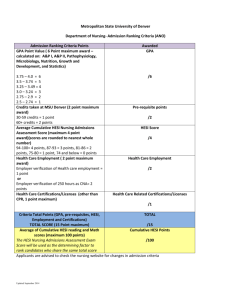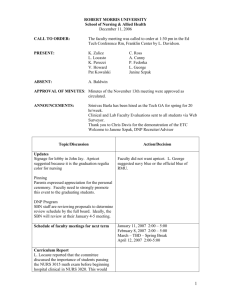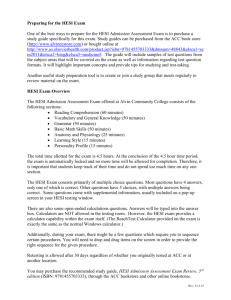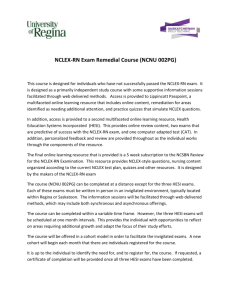Nurse Educator
advertisement
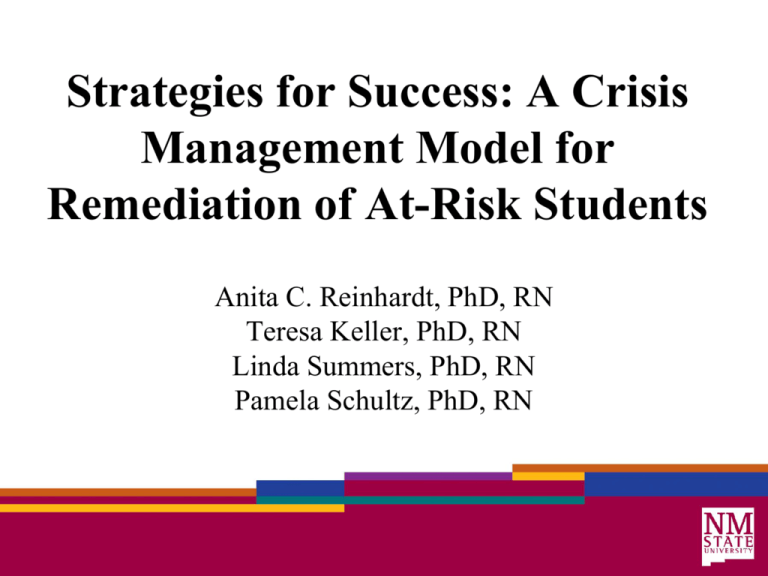
Strategies for Success: A Crisis Management Model for Remediation of At-Risk Students Anita C. Reinhardt, PhD, RN Teresa Keller, PhD, RN Linda Summers, PhD, RN Pamela Schultz, PhD, RN The start: N490 - Opportunity for Success: BSN Undergraduates Anita C. Reinhardt, PhD, RN Tenna R. Schumacher, MSN, RN Pamela Schultz, PhD, RN Project • Student’s Program success or failure • Remediation course (N490 - Opportunity for Success) • Presentation at Western Institute of Nursing Conference (Spring 2011) Rational/Background • Schools are adopting the HESI exit exam as a benchmark for progression (Nibert, Young, & Britt, 2008). • Students at risk for successful completion in nursing programs have been shown to benefit from a focused remediation course. Nibert, A. T., Young, A., & Britt, R. (2008). The HESI Exit Exam: progression benchmark and remediation guide... reprinted with permission from Nurs Educ 2003;28(3):141-145. Nurse Educator, 70S-774. Rational/Background • Research shows that the content of successful remediation courses varies, but most feature common strategies to help students become successful. • These strategies include faculty mentoring, test-taking strategies, and self-directed student activities. The Approach • Crisis Management for At-Risk Students (Elders, 2008) – – – – – Assess the individual and the problem Plan the intervention Implement the intervention Resolution of the Crisis Anticipatory planning Elders, D. (2008). Theory and intervention. In K. Fortinash & P. Holoday Worret (Eds.), Psychiatric/Mental Health Nursing (4th ed.). St. Louis, MO: Mosby-Elsevier. Setting • The BSN program is situated within a college of a land-grant University in the southwest southern border of the USA. • The undergraduate BSN program admits 48 students each semester for a four semester program and is accredited by CCNE. • The standardized testing products used for the program is offered by HESI. Setting • Prior to admission to the program, students are tested to indicate baseline assessment of basic knowledge gained from prerequisite courses required of BSN undergraduate students. • During the program various levels of ongoing knowledge are accessed and a HESI Exit exam is required prior to clinical placement in the preceptorship that is a culminating immersion clinical experience. Sample • Thirteen (13) students in danger of program dismissal. • The sample included 7 female, 6 males with a mean group age of 29 (range 23-41). • The cohort ethnic mix: 4 Anglo, 7 Hispanic, 1 Asian, and 1 African American. Sample • Some students had taken the Exit HESI exam as many as 9 times without success. • The minimum passing grade was 850 out of 1200 per HESI guidelines. • Students took the HESI Exit Exam as part of their final culminating nursing course while enrolled in the remediation course. Planning the Intervention • Review of the literature; development of evidence table • Discussion with course faculty leaders and the BSN and Program Director • Discussion with peers • Assess current practice for at-risk students Intervention Design • A retrospective project design was used to review pre-existing student test data from HESI exams • Develop the independent-study outcomes for a course offered in Spring Semester 2010. • IRB approval was obtained from NMSU for post hoc analysis. The Course • Students in danger of program dismissal due to repeated HESI failure were enrolled in a remediation course designed around – faculty engagement and mentoring, – focused reviews and self -assessment, – self-directed student content assessment with review plan, and – student engagement with their own learning process. The Course • In addition, students were provided an opportunity for individual test-taking counseling to assess study techniques and offered alternative study methods. Course Objectives Upon successful completion of the course, the student is expected to be able to: • Perform a self-evaluation for areas of strength and challenges in professional performance • Mobilize areas of emotional and academic strength to support successful performance Course Structure • Duration: 15 weeks • Class time: 3 hrs per week in face-to-face classroom • Engagement: – Mandatory attendance – Assessment on-line of self esteem – Self-developed plan of review based on areas of weakness found in previous HESI attempts – Required participation in group discussions Course Structure • Instruction format: – – – – Socratic questioning and discussion Practice tests Test reviews Power Point presentation in weak content area that included a teaching plan with pre-post test and self evaluation of the presentation – Registration and weekly progress reports of an external review program Implementing the Intervention • The N490 course was taught for the first time in Spring of 2010, with the purpose to determine if an evidence-based remediation course lead to improved student outcomes, including success with a program-required exit HESI exam and ultimate first-time success on the NCLEX-RN licensing exam. Results • All students successfully completed the remediation course and passed the HESI Exit Exam enabling them to complete the preceptorship and the BSN program. • NCLEX-RN first-time pass rate was 92% with 12/13 student results reported. • Only 1 of these student failed the NCLEX-RN on their first attempt. As last to report, this person was finally successful on their 2nd attempt. Now, the cohort has a 100% pass rate. Anticipatory Planning • Implement changes to the program – Pathophysiology became a pre-requisite course – Curricular review of BSN program objectives implemented – Continuation of the N490 course for any student atrisk (having failed a Nursing course). – Focused support (counseling or referral) of at-risk students • Minimum Admission HESI composite score level set by department Conclusion • The Crisis Intervention Model assisted in our approach to the development of the focused remediation. • A focused remediation course with engaged faculty involvement supports positive student outcomes and the production of qualified BSN graduates prepared to take and pass the NCLEX-RN examination successfully. What’s next? • Presentation – WIN 2011 (done) • Publish – JNE 2012 (done) • Expand – Ongoing work to analyze data and present WIN 2012 (done) and another article this time to Nurse Educator journal about use of HESI admission scores and student progress and outcomes (in final draft) • All scholarly work! References • • • • • • Allen, S. L. (2006). Mentoring: the magic partnership. Canadian Operating Room Nursing Journal, 24, 30. Baradell, J. G., Durham, C. F., Angel, B. F., Kaufman, J. S., & Lowdermilk, D. L. (1990). A comprehensive approach to preparation for NCLEX-RN. Journal of Nursing Education, 29, 109-113. Bentley, R. (2008). Comparison of traditional and accelerated baccalaureate nursing graduates... reprinted with permission from Nurs Educ 2006;31(2):79-83. Nurse Educator, 84S-888. Daley, L. K., Kirkpatrick, B. L., Frazier, S. K., Chung, M. L., & Moser, D. K. (2003). Predictors of NCLEX-RN success in a baccalaureate nursing program as a foundation for remediation. Journal of Nursing Education, 42, 390-398. DiBartolo, M. C. & Seldomridge, L. A. (2008). A review of intervention studies to promote NCLEX-RN success of baccalaureate students... reprinted with permission from Nurs Educ 2005;30(4):166-171. Nurse Educator, 78S-83s. Donabedian, A. (1985). Explorations in quality assessment and monitoring: The methods and findings of quality assessment and monitoring. (vols. Vol. 3) Ann Arbor, MI: Health Administration Press. References • English, J. B. & Gordon, D. K. (2004). Successful student remediation following repeated failures on the HESI exam. Nurse Educator, 29, 266-268. • Frierson, H. T., Jr., Malone, B., & Shelton, P. (1993). Enhancing NCLEXRN performance: assessing a three-pronged intervention approach. Journal of Nursing Education, 32, 222-224. • Frith, K. H., Sewell, J. P., & Clark, D. J. (2008). Best practices in NCLEXRN readiness preparation for baccalaureate student success... Reprinted with permission from Comput Inform Nurs 2005;23(6):322-329. Nurse Educator, 46S-53s. • Higgins, B. (2004). Relationship between retention and peer tutoring for at-risk students. Journal of Nursing Education, 43, 319-321. • Lauchner, K. A., Newman, M., & Britt, R. B. (2008). Predicting licensure success with a computerized comprehensive nursing exam: the HESI exit exam... reprinted with permission from Comput Nurs 1999;17(3):120-125. Nurse Educator, 4S-9s. References • • • • • • McGann, E. & Thompson, J. M. (2008). Factors related to academic success in atrisk senior nursing students. International Journal of Nursing Education Scholarship, 5, 1-15. Morrison, S., Adamson, C., Nibert, A., & Hsia, S. (2008). HESI exams: an overview of reliability and validity... reprinted with permission from Comput Inform Nurs 2004;22(4):220-226. Nurse Educator, 39S-45s. Morrison, S., Free, K. W., & Newman, M. (2008). Do progression and remediation policies improve NCLEX-RN pass rates?... reprinted with permission from Nurs Educ 2002;27(2):94-96. Nurse Educator, 67S-69. Morton, A. M. (2008). Improving NCLEX scores with structured learning assistance... reprinted with permission from Nurs Educ 2006;31(4):163-165. Nurse Educator, 89S-91s. Murray, K. T., Merriman, C. S., & Adamson, C. (2008). Use of the HESI admission assessment to predict student success... reprinted with permission from Comput Inform Nurs 2008;26(3):167-172. Nurse Educator, 61S-666. Newman, M., Britt, R. B., & Lauchner, K. A. (2008). Predictive accuracy of the HESI exit exam: a follow-up study... reprinted with permission from Comput Nurs 2000;18(3):132-136. Nurse Educator, 16S-20s. References • • • • • • Nibert, A. T. & Young, A. (2008). A third study on predicting NCLEX success with the HESI exit exam... Reprinted with permission from Comput Nurs 2001;19(4):172-178. Nurse Educator, 21S-227. Nibert, A. T., Young, A., & Adamson, C. (2008). Predicting NCLEX success with the HESI exit exam: fourth annual validity study... reprinted with permission from Comput Inform Nurs 2002;20(6):261-267. Nurse Educator, 28S-34s. Nibert, A. T., Young, A., & Britt, R. (2008). The HESI Exit Exam: progression benchmark and remediation guide... reprinted with permission from Nurs Educ 2003;28(3):141-145. Nurse Educator, 70S-774. Sewell, J., Culpa-Bondal, F., & Colvin, M. (2008). Nursing program assessment and evaluation: evidence-based decision making improves outcomes... reprinted with permission from Nurs Educ 2008;33(3):109-12. Nurse Educator, 98S-101s. Sifford, S. & McDaniel, D. M. (2007). Results of a remediation program for students at risk for failure on the NCLEX exam. Nursing Education Perspectives, 28, 34-36. Vance, A. & Davidhizar, R. (1997). Educational innovations. Strategies to assist students to be successful the next time around on the NCLEX-RN. Journal of Nursing Education, 36, 190-192.

